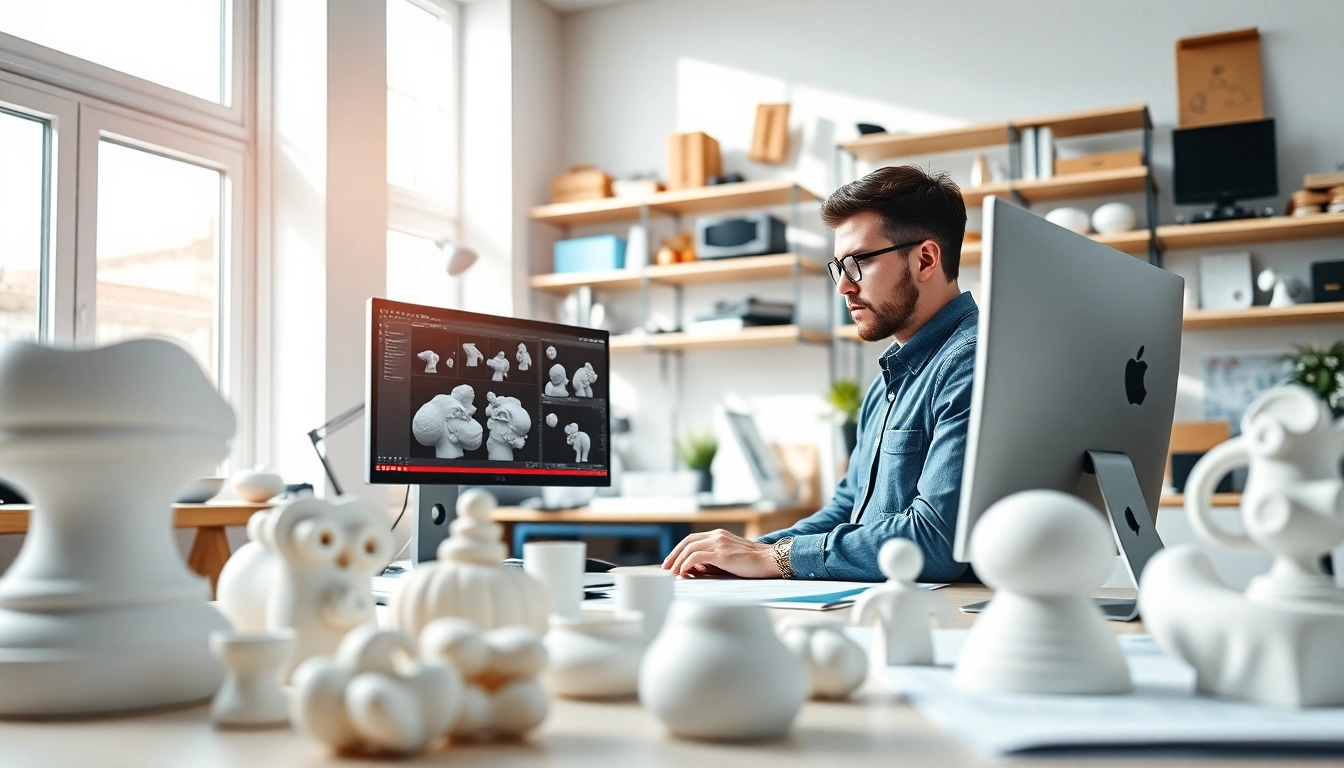Comprehensive Guide to Professional 3D Modeling Services and Solutions
The Essentials of 3D Modeling Services
In today’s digital landscape, the demand for 3D Modeling Services has surged across various sectors. From gaming to architectural visualization and product design, the role of 3D modeling is essential in creating realistic representations of ideas and concepts. This comprehensive guide aims to delve into the intricacies of 3D modeling services, providing insights into its applications, key features, industry relevance, and much more. By understanding the essentials, businesses and individuals can make informed decisions when seeking 3D modeling assistance.
Understanding 3D Modeling and Its Applications
3D modeling is the process of developing a mathematical representation of a three-dimensional object using specialized software. This technique has a myriad of applications across several industries:
- Product Design: Creating prototypes and visual assets for consumer goods.
- Entertainment: Used in video games and films for character and environment creation.
- Architecture: Visualizing building designs and landscapes with photorealistic simulations.
- Healthcare: Modeling human anatomy for educational and surgical planning purposes.
- Advertising: Enhancing marketing campaigns using 3D graphics for higher engagement rates.
These applications showcase the versatility and importance of effective 3D modeling in translating creative visions into realistic digital representations.
Key Features to Look for in 3D Modeling Services
When selecting a 3D modeling service, several features are essential to ensure quality and efficiency:
- Expertise in Software: Proficiency in leading software tools like Blender, Maya, or 3ds Max is vital. A well-rounded team should be adept in various platforms to meet specific project needs.
- Portfolio of Work: A strong portfolio showcasing previous 3D models is crucial. This can give clients a sense of style, technical capability, and the quality of work.
- Customization Options: Services should offer tailored solutions based on client requirements, whether it’s a complex model or a straightforward design.
- Fast Turnaround Times: Precision timing is often key in industries like product design where launching products quickly is essential.
- Post-Production Support: Additional services such as rendering and animation can enhance the final outcome, making it vital to choose a provider that offers such features.
The Role of 3D Modeling in Different Industries
The role of 3D modeling extends beyond mere aesthetics; it is integral to the functionality and success of various industries:
- Manufacturing: 3D models facilitate prototyping, enabling manufacturers to test products before production.
- Real Estate: Virtual tours powered by 3D models allow potential buyers to view properties from anywhere, increasing engagement.
- Aerospace and Defense: Accurate 3D models are critical in designing complex mechanical parts that meet stringent safety standards.
- Education: 3D educational tools create immersive learning experiences, enhancing understanding in fields such as geometry and anatomy.
- Fashion: Designers use 3D modeling to visualize clothing lines and streamline the design process, saving time and resources.
Choosing the Right 3D Modeling Service Provider
Criteria for Selecting a 3D Modeling Company
Selecting the right 3D modeling company involves careful consideration of multiple criteria:
- Experience: Look for companies with a proven track record in your specific industry.
- Client Testimonials: Reviews and feedback from previous clients can provide insights into the reliability and quality of the service provided.
- Communication Skills: Effective communication throughout the project is vital to ensure that the final product aligns with expectations.
- Technological Capabilities: The firm should be equipped with the latest software and hardware technology to produce high-quality models efficiently.
- Service Offerings: A company that offers comprehensive services from concept to final delivery is preferable, as it simplifies project management.
Evaluating Portfolios and Previous Work
When evaluating potential service providers, examining their portfolio is crucial. Here are some tips for assessing their previous work:
- Relevance: Look for projects similar to what you need. This indicates the company has the experience to handle your requirements.
- Quality: Assess the visual and technical quality of the models. Details like textures, lighting, and realism are significant indicators of skill.
- Diversity: A diverse portfolio showcasing various styles and industries indicates flexibility and creativity.
- Case Studies: Examine any provided case studies that explain the process, challenges, and outcomes of previous projects.
Understanding Pricing Models in 3D Services
Pricing can vary widely in the field of 3D modeling, and understanding different models can help in budgeting for projects:
- Hourly Rates: Many companies charge based on the time spent on the project. This is suitable for smaller projects with flexible scopes.
- Fixed Pricing: For well-defined projects, a fixed price may be more economical, as it provides clarity and predictability.
- Per Model Pricing: Companies might charge based on the complexity of the model. More intricate designs will naturally command higher fees.
- Retainer Agreements: Long-term clients may benefit from retainer agreements that offer dedicated resources for ongoing projects at a reduced rate.
Common Challenges in 3D Modeling
Identifying Potential Pitfalls in the Modeling Process
The path to an excellent 3D model is rife with challenges. Identifying potential pitfalls early can save time and resources:
- Miscommunication: Clients must clearly articulate their vision, while providing prototypes or sketches can significantly enhance understanding.
- Technical Limitations: Inadequate software or inexperienced modelers can lead to subpar results. Always ensure that the provider has the necessary tools and expertise.
- Time Constraints: Rushing the modeling process can compromise quality. Setting realistic timelines and expectations is essential.
- Budget Overruns: Projects can exceed budgets if unanticipated changes arise. Establishing a buffer or contingency plan can mitigate this risk.
Strategies to Overcome Technical Limitations
Technical challenges can impede project milestones. Here’s how to navigate these issues effectively:
- Investing in Software: Ensure that the modeling agency uses the latest and most effective 3D modeling software to enhance quality and speed.
- Continuous Training: Ongoing education for the design team in emerging technologies and trends keeps skills current and projects competitive.
- Prototyping: Creating an initial prototype allows for adjustments before full-scale implementation, identifying technical flaws early.
- Collaboration Tools: Utilizing collaboration tools can streamline communication and feedback among team members and clients, accelerating the design process.
Client Collaboration: Ensuring Clear Communication
Successful collaborations are grounded in clear communication. Here are strategies to enhance client-modeler communication:
- Regular Updates: Frequent check-ins and updates keep clients informed about progress and help address any concerns promptly.
- Feedback Mechanisms: Implement structured feedback practices, inviting clients to share their thoughts throughout the modeling process.
- Project Management Tools: Using project management software can keep both the modeling team and clients organized and aligned on goals and deadlines.
- Transparent Processes: Being transparent about the modeling workflow fosters trust and can lead to stronger relationships.
Best Practices for Successful 3D Modeling Projects
Tips for Working Effectively with 3D Modelers
Client involvement plays a critical role in the success of 3D modeling projects. Here are practical tips for effective collaboration:
- Define Clear Objectives: Establishing clear goals provides direction and purpose for the project, ensuring everyone is aligned.
- Use Visual References: Providing visual references such as sketches, images, or existing models can clarify expectations and reduce misunderstandings.
- Encourage Creative Input: Allow modelers to propose innovative ideas. Their expertise can lead to improvements that exceed initial expectations.
- Set Realistic Timelines: Timelines should reflect the complexity of the project and allow for potential revisions.
Maintaining Consistency Across Different Models
Consistency in design is essential, especially when creating multiple models that represent a brand or product line:
- Establish Style Guides: Develop a comprehensive style guide specifying colors, materials, and textures to maintain uniformity across models.
- Utilize Templates: Create templates for commonly used models. This standardizes features and simplifies the modeling process.
- Frequent Reviews: Conduct regular audits of models to ensure they adhere to the established guidelines.
- Encourage Team Feedback: Facilitate open feedback sessions among modelers, promoting a shared understanding of style and expectations.
Leveraging Feedback for Improved 3D Designs
Utilizing feedback effectively can enhance the quality of 3D designs:
- Solicit Constructive Criticism: Encourage team members and stakeholders to provide candid feedback to identify areas of improvement promptly.
- Implementation of Revisions: Actively revise models based on feedback to evolve designs and increase satisfaction.
- Documenting Changes: Keep a detailed record of feedback and subsequent changes to track improvements and better understand decision-making processes.
- Foster a Learning Environment: Create a culture where feedback is welcomed and valued, promoting innovation and iterative enhancements.
The Future of 3D Modeling Services
Emerging Trends and Technologies in 3D Modeling
The future of 3D modeling is bright, driven by several trends and advances in technology:
- Real-Time Rendering: New software capabilities allow designers to see changes instantaneously, streamlining the workflow.
- Integration with AR and VR: Immersive experiences enabled by augmented and virtual reality are gaining traction across industries, enhancing consumer engagement.
- Cloud-Based Solutions: Cloud technology promotes collaboration, enabling teams to work seamlessly from different parts of the world.
- Sustainability Initiatives: 3D modeling is increasingly being utilized in sustainable practices, allowing companies to test materials and designs before production, significantly reducing waste.
How AI is Transforming 3D Modeling Services
Artificial Intelligence is making significant inroads into 3D modeling, providing numerous advantages:
- Automated Design Processes: AI algorithms can generate 3D models based on specific parameters, significantly enhancing efficiency.
- Predictive Analytics: AI can analyze data from previous projects to forecast challenges and suggest possible solutions based on historical performance.
- Enhanced Realism: Machine learning algorithms can refine models by improving textures, lighting, and other visual elements, producing more lifelike representations.
- Cost Reduction: By streamlining processes and minimizing errors, AI can lower costs associated with 3D modeling projects.
Investment Opportunities in 3D Modeling Innovations
The growing demand for 3D modeling services presents considerable investment opportunities:
- Software Development: Investing in developing advanced 3D modeling software can yield high returns as businesses seek to enhance their creative output.
- Training and Education: As the industry evolves, opportunities arise for educational services to train existing professionals in new technologies and techniques.
- Consulting Services: Offering specialized consulting services to help businesses integrate 3D modeling into their workflows can be a lucrative niche.
- Startups and Innovations: Emerging startups focusing on innovative 3D modeling solutions present potential for investment and growth.



